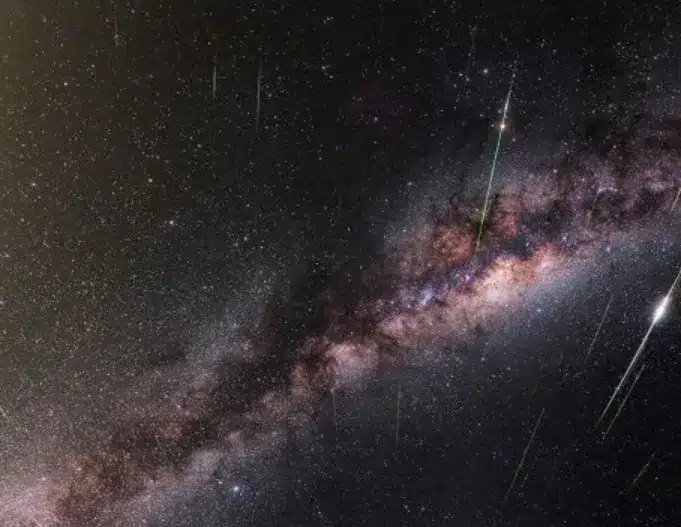What’s in today’s article?
- Why in News?
- What are comets?
- How exactly are meteor showers related to comets?
- Eta Aquariid meteor shower
Why in News?
The Eta Aquariid meteor shower, which has been active since April 15, will peak on May 5 and 6.
Comprising burning space debris moving at speeds of around 66 km per second (2.37 lakh kmph) into Earth’s atmosphere, these showers are seen in May every year. These are best visible to countries such as Indonesia and Australia in the Southern Hemisphere.
What are comets?
- About
- Comets are icy, small, cosmic snowballs of dust, rock, and frozen gases that orbit the Sun.
- They are often called dirty snowballs and are thought to be remnants from the formation of the solar system about 4.6 billion years ago.
- Composition
- Comets are made up of a nucleus, coma, hydrogen envelope, and dust and plasma tails.
- The nucleus is a loose collection of ice, dust, and small rocky particles that can range from a few hundred meters to tens of kilometers across.
- Location
- They are located in two regions of the solar system:
- Kuiper Belt – A wide disk beyond Neptune’s orbit that contains short-period comets that orbit the Sun in less than 200 years.
- Oort Cloud – A sphere-shaped region at the solar system’s outer edge that contains long-period comets that take much longer to orbit the Sun.
- They are located in two regions of the solar system:
- Features
- Comets orbit around the Sun in highly elliptical orbits which can, in some cases, take hundreds of thousands of years to complete.
- Comets come in different sizes, although most are roughly 10 km wide.
- However, as they come closer to the Sun, comets heat up and spew gases and dust into a glowing head that can be larger than a planet.
- This material also forms a tail which stretches millions of miles.
How exactly are meteor showers related to comets?
- Meteors are simply grains of dust or rock that burn up as they enter the Earth’s atmosphere. This burning also creates a brief tail.
- Since most meteors are tiny (the size of a grain of sand) they completely burn up in Earth’s atmosphere.
- However, once in a while, a large enough meteor passes through and hits the ground (at which time it is called a meteorite), often causing significant damage.
- A meteor shower can be observed when Earth passes through the clouds of dust left behind in a comet’s orbital plane.
- The sky lights up with small and large meteor tails as the debris left behind by the comet interacts with Earth’s atmosphere.
Eta Aquariid meteor shower
- About
- The Eta Aquariid meteor shower is formed when Earth passes through the orbital plane of the Halley’s Comet, which takes about 76 years to orbit the Sun once.
- The shower seems to be originating from the Aquarius constellation — hence ‘Eta Aquariid’.
- While it was observed as early as 240 BCE, it was only in 1705 that astronomer Edmond Halley realised that the periodic appearances were re-appearances of the same comet.
- Last seen in 1986, Halley’s comet is due to enter the inner solar system again in 2061.
- Like Eta Aquariids, the Orionids meteor shower is also caused by the Halley’s Comet, and appears every October.
- Uniqueness
- The Eta Aquariid meteor shower is known for its rapid speed. This makes for long, glowing tails which can last up to several minutes.
- According to NASA, about 30 to 40 Eta Aquariid meteors can be seen per hour during the peak of the meteor shower, if observed from the Southern Hemisphere.
- The number decreases to about 10 meteors per hour if being viewed in the Northern Hemisphere.
- This is due to the location of the “radiant” — the position in the sky where the meteor shower seems to come from.
- In the Northern Hemisphere, Eta Aquariid meteors most often appear as ‘Earthgrazers’ — long meteors which appear to skim the surface of the Earth.
- In the South, they can be seen higher up in the sky, and hence are more visible.
Q.1. What is Kuiper Belt?
The Kuiper Belt is a doughnut-shaped region of icy objects, dwarf planets, dust, and comets that extends beyond Neptune’s orbit in the outer solar system.
Q.2. What is Oort Cloud?
The Oort Cloud is a spherical shell of icy debris that surrounds our solar system, extending from 2,000 to 200,000 AU from the Sun. It’s located beyond Pluto and the Kuiper Belt, and is thought to contain billions or trillions of icy objects, sometimes the size of mountains or larger.
Source: Explained: The Eta Aquariid meteor shower and how it can be spotted | NASA Science
Last updated on June, 2025
→ UPSC Notification 2025 was released on 22nd January 2025.
→ UPSC Prelims Result 2025 is out now for the CSE held on 25 May 2025.
→ UPSC Prelims Question Paper 2025 and Unofficial Prelims Answer Key 2025 are available now.
→ UPSC Calendar 2026 is released on 15th May, 2025.
→ The UPSC Vacancy 2025 were released 1129, out of which 979 were for UPSC CSE and remaining 150 are for UPSC IFoS.
→ UPSC Mains 2025 will be conducted on 22nd August 2025.
→ UPSC Prelims 2026 will be conducted on 24th May, 2026 & UPSC Mains 2026 will be conducted on 21st August 2026.
→ The UPSC Selection Process is of 3 stages-Prelims, Mains and Interview.
→ UPSC Result 2024 is released with latest UPSC Marksheet 2024. Check Now!
→ UPSC Toppers List 2024 is released now. Shakti Dubey is UPSC AIR 1 2024 Topper.
→ Also check Best IAS Coaching in Delhi






















